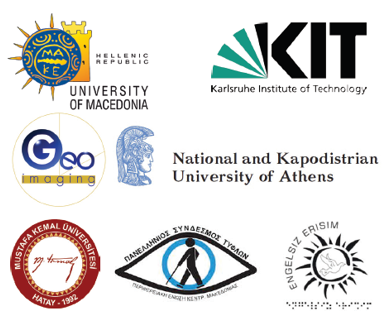3rd Issue, November 2015

ATMAPS - Specification of symbols used on audio-tactile maps for individuals with blindness
Newsletter No. 3
ATMAPS is in its 2nd year
Welcome to the third Newsletter of the ATMAPS project. In this newsletter, we want to inform you about the progress in our project "Specification of symbols used on audio-tactile maps for individuals with blindness (ATMAPS)". It has been one and a half years since the beginning of the implementation of the project and in this issue, we will provide information about what we have accomplished during the third semester of the project (months 12-18).
3rd Progress Meeting held in Athens, Greece at the National Kapodistrian University of Athens
Representatives from six partner organizations attended the second progress meeting of the project marking the end of the third quarter. We had to discuss and make decisions about one of the most tedious steps of the research.

The project’s external evaluator Professor Vassilios Argyropoulos (University of Thessaly) also attended the meeting in order to observe the work on site and to provide feedback.
The testing procedures were discussed, foreseen issues that could be encountered during the implementation were contemplated upon, and standard implementation of the procedures across application sites (in Athens, Thessaloniki, Istanbul, Karlsruhe and Cyprus) was ensured.
Specific instructions were provided on how the testing instruments to be used during the testing procedure and how the tactile material should be printed. The implementation procedures were demonstrated and feedback from blind members of the consortium were received in addition to the researchers' concerns being addressed.

Highlights of progress in our Study - Evaluation of Tactile Symbols
During the last weeks, all partners were very busy testing the tactile symbols developed with participating individuals with visual impairments. In a first step, all partners gathered experiences in performing the tests. The experiences were discussed within the project and the procedure was adapted.

The tests were conducted in all partner countries i.e. Greece, Germany, Turkey and Cyprus. We tested over 100 individuals with visual impairments by asking them to evaluate the ease of identification of 20 areal, 40 linear and 100 point symbols included in tactile printouts (symbols printed on microcapsule paper).
This is an important step for the ATMAPS project as tactile and visual perception differs and we needed to evaluate the legibility (ease of identification) of the tactile symbols created based on research evidence, in order to define the tactile symbols that are more easily identified by users.
We are very grateful that we found so many participants with blindness and low vision willing to participate in the study and we would like to thank everyone who contributed and dedicated their time and efforts to this study.
The data of the research study will be statistically analyzed within the next weeks and the findings will be reported in the next newsletter.
What is Next?
In order to reach a final decision for the choice of the symbols to be used on the audio tactile maps, specific indicators will be used as well as the findings of the statistical analysis of the data collected from the "Evaluation of Tactile Symbols" phase.
This multi-level analysis approach will contribute to the level of readability and ease of identification of the selected symbols.
The next step will be to develop and test the standardized audio-tactile symbols, create audio-tactile maps and training material for the end-users.
Contact
Prof. Konstantinos Papadopoulos
University of Macedonia
Research Committee
156, Egnatia str
GR-54006
Website: www.atmaps.eu
Email: info@atmaps.eu
ATMAPS Consortium
|
 |
 This project (543316-LLP-1-2013-1-GR-KA3-KA3MP) has been funded with support from the European Commission. This publication [communication] reflects the views only of the author, and the Commission cannot be held responsible for any use which may be made of the information contained therein.
This project (543316-LLP-1-2013-1-GR-KA3-KA3MP) has been funded with support from the European Commission. This publication [communication] reflects the views only of the author, and the Commission cannot be held responsible for any use which may be made of the information contained therein.